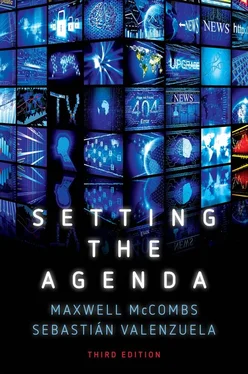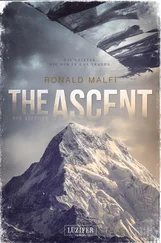Maxwell McCombs - Setting the Agenda
Здесь есть возможность читать онлайн «Maxwell McCombs - Setting the Agenda» — ознакомительный отрывок электронной книги совершенно бесплатно, а после прочтения отрывка купить полную версию. В некоторых случаях можно слушать аудио, скачать через торрент в формате fb2 и присутствует краткое содержание. Жанр: unrecognised, на английском языке. Описание произведения, (предисловие) а так же отзывы посетителей доступны на портале библиотеки ЛибКат.
- Название:Setting the Agenda
- Автор:
- Жанр:
- Год:неизвестен
- ISBN:нет данных
- Рейтинг книги:4 / 5. Голосов: 1
-
Избранное:Добавить в избранное
- Отзывы:
-
Ваша оценка:
- 80
- 1
- 2
- 3
- 4
- 5
Setting the Agenda: краткое содержание, описание и аннотация
Предлагаем к чтению аннотацию, описание, краткое содержание или предисловие (зависит от того, что написал сам автор книги «Setting the Agenda»). Если вы не нашли необходимую информацию о книге — напишите в комментариях, мы постараемся отыскать её.
, first published in 2004, has become the go-to textbook on this crucial topic.
In this timely third edition, Maxwell McCombs – a pioneer of agenda-setting research – and Sebastián Valenzuela – a senior scholar of agenda setting in Latin America – have expanded and updated the book for a new generation of students. In describing the media's influence on what we think about and how we think about it,
also examines the sources of media agendas, the psychological explanation for their impact on the public agenda, and their consequences for attitudes, opinions and behaviours. New to this edition is a discussion of agenda setting in the widened media landscape, including a full chapter on network agenda setting and a lengthened presentation on agenda melding. The book also contains expanded material on social media and the role of agenda setting beyond the realm of public affairs, as well as a foreword from Donald L. Shaw and David H. Weaver, the co-founders of agenda-setting theory.
This exciting new edition is an invaluable source for students of media, communications and politics, as well as those interested in the role of news in shaping and directing public opinion.
Setting the Agenda — читать онлайн ознакомительный отрывок
Ниже представлен текст книги, разбитый по страницам. Система сохранения места последней прочитанной страницы, позволяет с удобством читать онлайн бесплатно книгу «Setting the Agenda», без необходимости каждый раз заново искать на чём Вы остановились. Поставьте закладку, и сможете в любой момент перейти на страницу, на которой закончили чтение.
Интервал:
Закладка:
Returning to the previous comparisons between agenda-setting effects of daily newspapers among contemporary generations:
despite evidence that the youngest generation is not exposed to traditional media as frequently as the older generations, and does use the Internet significantly more, there is little support for the intuitive idea that diversity of media will lead to the end of a common public agenda as we have known it. Rather, different media use among the young did not seem to influence the agenda-setting effect much at all. 65
During the 2006 Swedish national election, Jesper Stromback and Spiro Kiousis measured the impact of daily news use across nine major news media – a mix of newspapers, television, and radio – and found that:
attention to political news exerts a significant and rather strong influence on perceived issue salience and that attention to political news matters more than attention to various specific news shows on television and in radio, or to different newspapers. 66
This finding does not deny that there are powerful and influential newspapers, broadcast stations, and websites. However, zooming out for a broader look, it is the vast gestalt of communication voices that defines our social fabric. Often, the major effects of communication result from the collective impact of the media and a continuous process of civic osmosis. An important aspect of civic osmosis is the sheer number of news channels available to the public. At the individual level, the number of different problems mentioned by respondents when asked to name the most important problems facing the local community or the nation is significantly related to the number of media voices in the community. 67
Summing up
This is far from all the accumulated evidence that the news media exercise an agenda-setting influence on the public, but it is a wide-ranging sample of that evidence. The examples presented here describe agenda-setting effects by a wide array of media on numerous national and local issues, during elections and more quiescent political times, in a variety of national and local settings in the United States, Britain, Spain, Germany, Japan, and Argentina, from 1968 to the present. Recent research also has documented the agenda-setting effects of entertainment media, such as Oprah Winfrey’s daytime TV show. 68
There are, of course, several other significant influences that shape individual attitudes and public opinion. How we feel about a particular issue may be rooted in our personal experience, the general culture or our exposure to the media. 69Trends in public opinion are shaped over time by new generations, external events, and the communication media. 70Nonetheless, the general proposition supported by this accumulation of evidence about agenda-setting effects is that journalists do significantly influence their audience’s picture of the world.
For the most part, this agenda-setting influence is an inadvertent by-product of the media’s necessity to focus on a few topics in the news each day. And a tight focus on a handful of issues by numerous media conveys a strong message to the audience about what are the most important topics of the moment. Agenda setting directs our attention to the early formative stages of public opinion, when issues emerge and first engage public attention, a situation that confronts journalists with a strong ethical responsibility to select carefully the issues on their agenda.
In theoretical terms, this chapter’s examples of agenda setting illustrate the transmission of issue salience from the media agenda to the public agenda. As we shall see in subsequent chapters, agenda setting as a theory about the transmission of salience is not limited to the influence of the media agenda on the public agenda, or even to an agenda of public issues. There are many agendas in contemporary society. Beyond the various agendas that define the context in which public opinion takes shape, this idea about the transmission of salience has been applied to a variety of other settings. Chapter 8discusses some of these new, broader applications, that extend agenda-setting theory beyond political communication. But, first, we will add further detail to our theoretical map of the causal influence that the media agenda has on the public agenda.
Notes
1 Walter Lippmann, Public Opinion (New York: Macmillan, 1922), p. 29. 2 Robert Park, ‘News as a form of knowledge’, American Journal of Sociology, 45 (1940): 667–86. 3 Propaganda, however, can have agenda-setting effects. For instance, there is some evidence that ‘fake news’ websites – sites that deliberatively spread misperceptions and fabricated content – influenced the agenda of fact-based media during the 2016 US presidential election; see Chris J. Vargo, Lei Guo, and Michelle A. Amazeen, ‘The agenda-setting power of fake news: a big data analysis of the online media landscape from 2014 to 2016’, New Media and Society, 20 (2018): 2028–49. 4 Bernard Cohen, The Press and Foreign Policy (Princeton, NJ: Princeton University Press, 1963), p. 13. 5 Lippmann, Public Opinion, p. 3. 6 Ibid., p. 4. 7 Paul Lazarsfeld, Bernard Berelson, and Hazel Gaudet, The People’s Choice (New York: Duell, Sloan, and Pearce, 1944). 8 Joseph Klapper, The Effects of Mass Communication (New York: Free Press, 1960), p. 8. 9 See, for instance, Robert E. Park, ‘The city: suggestions for investigation of human behavior in the urban environment’, in Robert E. Park and Ernest W. Burgess, eds., The City (Chicago, IL: University of Chicago Press, 1925), pp. 1–46; Paul F. Lazarsfeld and Robert K. Merton, ‘Mass communication, popular taste and organized social action’, in Guy E. Swanson, Theodore M. Newcomb, and Eugene L. Hartley, eds., Readings in Social Psychology (rev. edn) (New York, NY: Henry Holt and Company, 1952), pp. 74–85.10 Maxwell McCombs and Donald Shaw, ‘The agenda setting function of mass media’, Public Opinion Quarterly, 36 (1972): 176–87.11 Yeojin Kim, Youngju Kim, and Shuhua Zhou, ‘Theoretical and methodological trends of agenda-setting theory: a thematic analysis of the last four decades of research’, Agenda Setting Journal, 1 (2017): 5–22.12 Stanley Presser, ‘Substance and method in Public Opinion Quarterly, 1937–2010’, Public Opinion Quarterly, 75 (2011): 839–45. Details in Table 2 (p. 843). For additional background on citations to the Chapel Hill study, see W. Russell Neuman and Lauren Guggenheim, ‘The evolution of media effects theory: a six-stage model of cumulative research’, Communication Theory, 21 (2011): 169–96. For details, see p. 180.13 W. Lance Bennett and Shanto Iyengar, ‘A new era of minimal effects? The changing foundations of political communication’, Journal of Communication, 58 (2008): 707–31. Quote from p. 708.14 Yunjuan Luo, Hansel Burley, Alexander Moe, and Mingxiao Sui, ‘A meta-analysis of news media’s public agenda-setting effects, 1972–2015’, Journalism and Mass Communication Quarterly, 96 (2019): 150–72.15 Stephen A. Rains, Timothy R. Levine, and Rene Weber, ‘Sixty years of quantitative communication research summarized: lessons from 149 meta-analyses’, Annals of the International Communication Association, 42 (2018): 105–24.16 Donald Shaw and Maxwell McCombs, eds., The Emergence of American Political Issues (St Paul, MN: West, 1977).17 David H. Weaver, Doris A. Graber, Maxwell E. McCombs, and Chaim H. Eyal, Media Agenda Setting in a Presidential Election: Issues, Images and Interest (Westport, CT: Greenwood, 1981).18 James Winter and Chaim Eyal, ‘Agenda setting for the civil rights issue’, Public Opinion Quarterly, 45 (1981): 376–83.19 Stuart N. Soroka, ‘Media, public opinion, and foreign policy’, Harvard International Journal of Press/Politics, 8 (2003): 27–48.20 Hans-Bernd Brosius and Hans Mathias Kepplinger, ‘The agenda setting function of television news: static and dynamic views’, Communication Research, 17 (1990): 183–211.21 Adam Shehata, ‘Unemployment on the agenda: a panel study of agenda setting effects during the 2006 Swedish national election campaign’, Journal of Communication, 60 (2010): 182–203.22 Kim Smith, ‘Newspaper coverage and public concern about community issues’, Journalism Monographs, 101 (1987).23 Maria José Canel, Juan Pablo Llamas, and Federico Rey, ‘El primer nivel del efecto agenda setting en la información local: los “problemas más importantes” de la ciudad de Pamplona’ [‘The first level agenda setting effect on local information: the “most important problems” of the city of Pamplona’], Comunicación y Sociedad, 9, 1 and 2 (1996): 17–38.24 Toshio Takeshita, ‘Agenda setting effects of the press in a Japanese local election’, Studies of Broadcasting, 29 (1993): 193–216.25 Federico Rey Lennon, Los Diarios Nacionales y la Campaña Electoral: Argentina, 1997 Elecciones [The national press and the electoral campaign: Argentina, the 1997 elections] (Buenos Aires: Freedom Forum and Universidad Austral, 1998).26 Alicia Casermeiro de Pereson, Los medios en las elecciones: la agenda setting en la ciudad de Buenos Aires [The media in the elections: Agenda setting in the city of Buenos Aires] (Buenos Aires, Argentina, EDUCA, 2003).27 Howard Eaton Jr, ‘Agenda setting with bi-weekly data on content of three national media’, Journalism Quarterly, 66 (1989): 942–8.28 McCombs and Shaw, ‘The agenda setting function of mass media.’29 Shaw and McCombs, The Emergence of American Political Issues.30 Weaver, Graber, McCombs and Eyal, Media Agenda Setting in a Presidential Election.31 Winter and Eyal, ‘Agenda setting for the civil rights issue.’32 Eaton, ‘Agenda setting with bi-weekly data on content of three national media.’33 Brosius and Kepplinger, ‘The agenda setting function of television news.’34 Smith, ‘Newspaper coverage and public concern about community issues.’35 Shanto Iyengar and Donald R. Kinder, News That Matters: Television and American Opinion (Chicago: University of Chicago Press, 1987).36 Scott L. Althaus and David Tewksbury, ‘Agenda setting and the “new” news: patterns of issue importance among readers of the paper and online versions of the New York Times’, Communication Research, 29 (2002): 180–207. Quote is on p. 199.37 Michael Conway and J. R. Patterson, ‘Today’s top story? An agenda setting and recall experiment involving television and Internet news’, Southwestern Mass Communication Journal, 24 (2008): 31–48.38 Gary King, Benjamin Schneer, and Ariel White, ‘How the news media activate public expression and influence national agendas’, Science, 358 (2017): 776–80.39 Matthew Gentzkow, ‘Small media, big impact: Randomizing news stories reveals broad public impacts’, Science, 358 (2017): 726–7. Quote is on p. 727.40 Mike Gruszczynski and Michael W. Wagner, ‘Information flow in the 21st century: the dynamics of agenda-uptake’, Mass Communication and Society, 20 (2017): 378–402; Sharon Meraz, ‘Using time series analysis to measure intermedia agenda-setting influence in traditional media and political blog networks’, Journalism and Mass Communication Quarterly, 88 (2011): 176–94; Kevin Wallsten ‘Agenda setting and the blogosphere: An analysis of the relationship between mainstream media and political blogs’, Review of Policy Research, 24 (2007): 567–87.41 For particular case studies, see Jacob Groshek and Megan Clough Groshek, ‘Agenda-trending: reciprocity and the predictive capacity of social networking sites in intermedia agenda-setting across topics over time’, Media and Communication, 1, 1, 2013: 15–27; Raymond A. Harder, Julie Sevenans, and Peter Van Aelst, ‘Intermedia agenda setting in the social media age: How traditional players dominate the news agenda in election times’, International Journal of Press/Politics, 22, 3 (2017): 275–93; Ingrid Rogstad, ‘Is Twitter just rehashing? Intermedia agenda setting between Twitter and mainstream media’, Journal of Information Technology and Politics, 13, 2 (2016): 142–58; Ben Sayre, Leticia Bode, Dhavan Shah, Dave Wilcox, and Chirag Shah, ‘Agenda setting in a digital age: tracking attention to California Proposition 8 in social media, online news and conventional news,’’, Policy and Internet, 2, 2 (2010): 7–32; Kathleen Searles and Glen Smith, ‘Who’s the boss? Setting the agenda in a fragmented media environment,’’, International Journal of Communication, 10 (2016): 2074–95; Sebastián Valenzuela, Soledad Puente, and Pablo M. Flores, ‘Comparing disaster news on Twitter and television: An intermedia agenda setting perspective’, Journal of Broadcasting and Electronic Media, 61 (2017): 615–37; Chris J. Vargo and Lei Guo, ‘Networks, big data, and intermedia agenda setting: an analysis of traditional, partisan, and emerging online US news’, Journalism and Mass Communication Quarterly, 94 (2017): 1031–55.42 Hai Tran, ‘Online agenda setting: a new frontier for theory development’, in Agenda Setting in a 2.0 World, ed. Thomas J. Johnson (New York: Routledge, 2013), pp. 205–29.43 Jason Martin, ‘Agenda setting, elections and the impact of information technology’, in Agenda Setting in a 2.0 World, ed. Thomas J. Johnson (New York: Routledge, 2013), pp. 28–52.44 Conway and Patterson, ‘Today’s top story?’; Althaus and Tewksbury, ‘Agenda setting and the “new” news.’45 Yonghoi Song, ‘Internet news media and issue development: a case study on the roles of independent online news services as agenda-builders for anti-US protests in South Korea’, New Media and Society, 9 (2007): 71–92.46 Jae Kook Lee, ‘The effect of the Internet on homogeneity of the media agenda: a test of the fragmentation thesis’, Journalism and Mass Communication Quarterly, 84 (2007): 745–60.47 Ana S. Cardenal, Carol Galais, and Silvia Majó-Vázquez, ‘Is Facebook eroding the public agenda? Evidence from survey and web-tracking data’, International Journal of Public Opinion Research, 31, (2019): 589–608.48 Pablo Barberá, Andreu Casas, Jonathan Nagler, Patrick J. Egan, Richard Bonneau, John T. Jost, and Joshua A. Tucker, ‘Who leads? Who follows? Measuring issue attention and agenda setting by legislators and the mass public using social media data’, American Political Science Review, 113 (2019): 883–901.49 Ibid., p. 897.50 G. R. Boynton and Glenn W. Richardson, Jr, ‘Agenda setting in the twenty-first century’, New Media and Society, 18 (2016): 1916–34.51 Steven H. Chaffee and Miriam J. Metzger, ‘The end of mass communication?’, Mass Communication and Society, 4 (2001): 365–79; Bennett and Iyengar, ‘A new era of minimal effects?’; Bruce A. Williams and Michael X. Delli Carpini, ‘Monica and Bill all the time and everywhere: The collapse of gatekeeping and agenda setting in the new media environment’, American Behavioral Scientist, 47 (2004): 1208–30.52 Few argue that people’s attention span has diminished as a consequence of a high-choice media environment. See, e.g. Philipp Lorenz-Spreen, Bjarke Mørch Mønsted, Philipp Hövel, and Sune Lehmann, ‘Accelerating dynamics of collective attention’, Nature Communications, 10, 1759 (2019). Active attention to media content, however, is not the only path through which people learn the media agenda, as there is evidence that the process can also operate incidentally, through cues. See Maxwell McCombs and Natalie J. Stroud, ‘Psychology of agenda-setting effects: Mapping the paths of information processing’, Review of Communication Research, 2 (2014): 68–93; Elizabeth Stoycheff, Raymond J. Pingree, Jason T. Peifer, and Mingxiao Sui, ‘Agenda cueing effects of news and social media’, Media Psychology, 21, 2 (2018): 182–201.53 Yue Tan and David Weaver, ‘Agenda diversity and agenda setting from 1956 to 2004: what are the trends over time?’, Journalism Studies, 14, (2013): 773–89.54 Monika Djerf-Pierre and Adam Shehata, ‘Still an agenda setter: traditional news media and public opinion during the transition from low to high choice media environments’, Journal of Communication, 67 (2017): 733–57.55 Daniela Grassau, ‘Has TV decreased impact on public opinion due to the transformations of the media environment in the 21st century?’, paper presented to the International Association for Media and Communication Research, Madrid, 2019.56 Renita Coleman and Maxwell McCombs, ‘The young and agenda-less? Age-related differences in agenda setting on the youngest generation, baby boomers, and the civic generation’, Journalism and Mass Communication Quarterly, 84 (2007): 495–508.57 Jae Kook Lee and Renita Coleman, ‘Testing generational, life cycle, and period effects of age on agenda setting’, Mass Communication and Society, 17, 1 (2014): 3–25.58 Yunjuan Luo, Hansel Burley, Alexander Moe, and Mingxiao Sui, ‘A meta-analysis of news media’s public agenda-setting effects, 1972–2015.’59 Pablo Boczkowski, News at Work: Imitation in an Age of Information Abundance (Chicago: University of Chicago Press, 2010).60 Maxwell McCombs, ‘Civic osmosis: the social impact of media’, Communication and Society, 25 (2012): 7–14.61 James Webster and Thomas Ksiazek, ‘The dynamics of audience fragmentation: public attention in an age of digital media’, Journal of Communication, 62 (2012): 39–56. Quote is on p. 39.62 Hyun, Ki Deuk, and Soo Jung Moon, ‘Agenda setting in the partisan TV news context: attribute agenda setting and polarized evaluation of presidential candidates among viewers of NBC, CNN, and Fox News’, Journalism and Mass Communication Quarterly, 93 (2016): 509–29.63 Lazarsfeld, Berelson and Gaudet, The People’s Choice, p. 122.64 Maxwell McCombs, Esteban López-Escobar, and Juan Pablo Llamas, ‘Setting the agenda of attributes in the 1996 Spanish general election’, Journal of Communication, 50, 2 (2000): 77–92.65 Coleman and McCombs, ‘The young and agenda-less?.’ Quote on p. 503.66 Jesper Stromback and Spiro Kiousis, ‘A new look at agenda setting effects – Comparing the predictive power of overall political news consumption and specific news media consumption across different media channels and media types’, Journal of Communication, 60 (2010): 271–92. Quote is on p. 288 (emphasis in original).67 Steven Chaffee and Donna Wilson, ‘Media rich, media poor: two studies of diversity in agenda-holding’, Journalism Quarterly, 54 (1977): 466–76. Also see Peter Jochen and Claes H. de Vreese, ‘Agenda-rich, agenda-poor: a cross-national comparative investigation of nominal and thematic public agenda diversity’, International Journal of Public Opinion Research, 15 (2003): 44–64.68 See for example, Mark Boukes, ‘Agenda-setting with satire: how political satire increased TTIP’S saliency on the public, media, and political agenda’, Political Communication, 36 (2019): 426–51; Xiaoxia Cao, ‘Hearing it from Jon Stewart: the impact of The Daily Show on public attentiveness to politics’, International Journal of Public Opinion Research, 22 (2010): 26–46; J. Carroll Glynn, Michael Huge, James Reineke, Bruce Hardy and James Shanahan, ‘When Oprah intervenes: political correlates of daytime talk show viewing’, Journal of Broadcasting and Electronic Media, 51 (2007): 228–44.69 William Gamson, Talking Politics (New York: Cambridge University Press, 1992).70 William G. Mayer, The Changing American Mind: How and Why American Public Opinion Changed between 1960 and 1988 (Ann Arbor: University of Michigan Press, 1992).
Читать дальшеИнтервал:
Закладка:
Похожие книги на «Setting the Agenda»
Представляем Вашему вниманию похожие книги на «Setting the Agenda» списком для выбора. Мы отобрали схожую по названию и смыслу литературу в надежде предоставить читателям больше вариантов отыскать новые, интересные, ещё непрочитанные произведения.
Обсуждение, отзывы о книге «Setting the Agenda» и просто собственные мнения читателей. Оставьте ваши комментарии, напишите, что Вы думаете о произведении, его смысле или главных героях. Укажите что конкретно понравилось, а что нет, и почему Вы так считаете.












